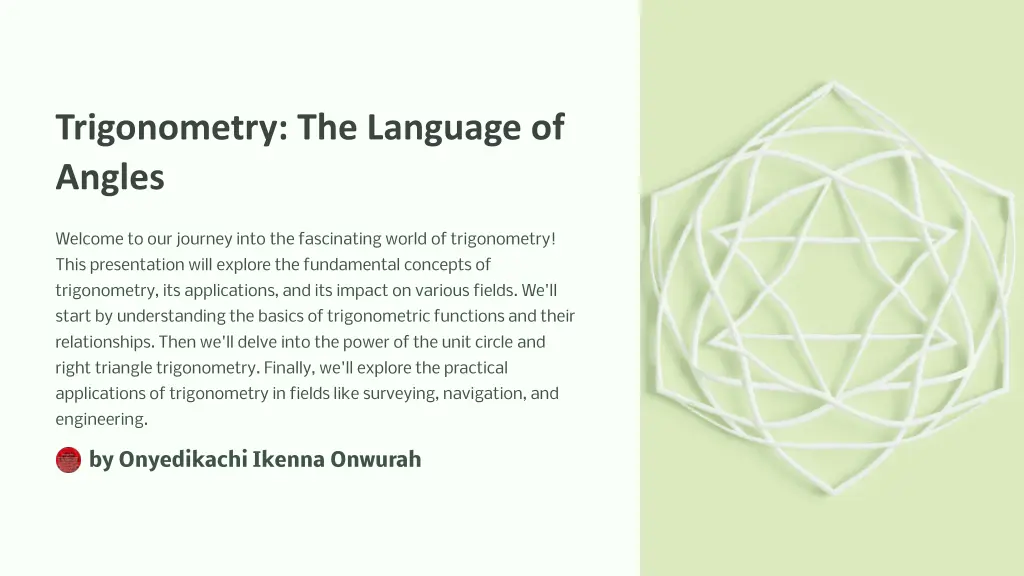
Trigonometry Fundamentals: Basics, Functions & Applications
Explore the basics of trigonometry, including trigonometric functions (sine, cosine, tangent), the unit circle, right triangle trigonometry, and inverse trigonometric functions. Discover the practical applications of trigonometry in fields like surveying, navigation, and engineering.
Download Presentation

Please find below an Image/Link to download the presentation.
The content on the website is provided AS IS for your information and personal use only. It may not be sold, licensed, or shared on other websites without obtaining consent from the author. If you encounter any issues during the download, it is possible that the publisher has removed the file from their server.
You are allowed to download the files provided on this website for personal or commercial use, subject to the condition that they are used lawfully. All files are the property of their respective owners.
The content on the website is provided AS IS for your information and personal use only. It may not be sold, licensed, or shared on other websites without obtaining consent from the author.
E N D
Presentation Transcript
Trigonometry: The Language of Angles Welcome to our journey into the fascinating world of trigonometry! This presentation will explore the fundamental concepts of trigonometry, its applications, and its impact on various fields. We'll start by understanding the basics of trigonometric functions and their relationships. Then we'll delve into the power of the unit circle and right triangle trigonometry. Finally, we'll explore the practical applications of trigonometry in fields like surveying, navigation, and engineering. by Onyedikachi Ikenna Onwurah preencoded.png
Defining Trigonometric Functions: Sine, Cosine, and and Tangent Sine Cosine Tangent Sine is the ratio of the side opposite Cosine is the ratio of the side Tangent is the ratio of the side an angle to the hypotenuse. It is adjacent to an angle to the opposite an angle to the side represented by the abbreviation sin. hypotenuse. It is represented by the adjacent to the angle. It is abbreviation cos. represented by the abbreviation tan. preencoded.png
The Unit Circle: Understanding Radian Measure Understanding Radian Measure Unit Circle as a Reference Connecting Angles and Coordinates 1 2 3 The unit circle is a powerful tool for Radian measure represents angles as The unit circle enables us to connect visualizing trigonometric functions the ratio of arc length to radius. It's angles in radians with corresponding and their values across different angles. It allows us to understand crucial for understanding trigonometric functions in their coordinates on the circle, offering a visual representation of the the cyclical nature of these entirety. relationship between angles and functions. trigonometric functions. preencoded.png
Right Triangle Trigonometry: Solving for Sides and Angles SOH CAH TOA Remember the acronym SOH CAH TOA to easily recall the relationships between sides and angles in a right triangle. It represents Sine, Opposite, Hypotenuse; Cosine, Adjacent, Hypotenuse; and Tangent, Opposite, Adjacent. Finding Unknown Sides Using trigonometric functions, we can solve for the lengths of unknown sides in a right triangle when we know one side and one angle. The known angle and side determine the trigonometric function to use. Determining Unknown Angles Inverse trigonometric functions, such as arcsine, arccosine, and arctangent, allow us to determine the measure of an unknown angle when two sides of a right triangle are known. preencoded.png
Inverse Trigonometric Functions: Arcsine, Arcsine, Arccosine, and Arctangent Arcsine (sin ) Arcsine is used to find the angle whose sine is a given value. For example, arcsin(0.5) equals 30 degrees, as the sine of 30 degrees is 0.5. Arccosine (cos ) Arccosine is used to find the angle whose cosine is a given value. For example, arccos(0.866) equals 30 degrees, as the cosine of 30 degrees is 0.866. Arctangent (tan ) Arctangent is used to find the angle whose tangent is a given value. For example, arctan(1) equals 45 degrees, as the tangent of 45 degrees is 1. preencoded.png
Trigonometric Identities: Foundational Relationships Pythagorean Identity Quotient Identities sin + cos = 1. This identity is tan = sin /cos , cot = cos /sin . These identities relate based on the Pythagorean theorem and holds true for any angle . the tangent and cotangent functions to sine and cosine. Reciprocal Identities csc = 1/sin , sec = 1/cos , cot = 1/tan . These identities define the cosecant, secant, and cotangent functions as reciprocals of sine, cosine, and tangent, respectively. preencoded.png
Applications of Trigonometry: From From Surveying to Navigation Surveying 1 Trigonometry is crucial in surveying to determine distances, elevations, and angles. Surveyors use trigonometric functions and measurements to create accurate maps and plans. Navigation 2 Navigators rely on trigonometry to calculate courses, distances, and positions. From sailing ships to guiding aircraft, trigonometry plays a vital role in navigation. Engineering 3 Trigonometry is essential in engineering to design and analyze structures, bridges, and other constructions. It helps determine forces, angles, and stresses in these structures. preencoded.png
Trigonometry in the Modern World: Exploring Relevant Use Cases 3D Modeling 3D Modeling Trigonometry is used in 3D modeling to create realistic and accurate representations of objects and scenes. It helps in defining the position and orientation of objects in space. Audio Processing Audio Processing Trigonometry plays a crucial role in audio processing by manipulating sound waves and signals. It's used for tasks such as filtering, equalization, and effects processing. Image Processing Image Processing Trigonometry is utilized in image processing for tasks like image resizing, rotation, and geometric transformations. It helps manipulate and analyze pixel data in images. preencoded.png
